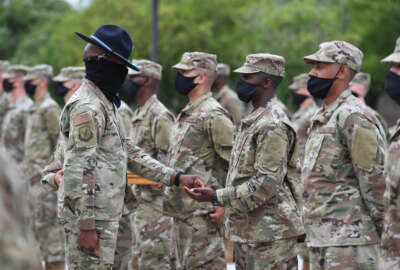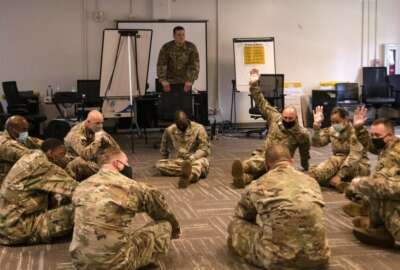Air Force to fall short of recruiting goal for first time since 1999
The active duty Air Force will fall about 10% short of its recruiting goal this year, and its reserve components will see shortfalls closer to 30%.
Amid a recruiting crisis that’s impacted each of the military services for the last several years, the Air Force has fared better than most. This year though, it will join the Army and Navy in failing to meet its recruiting goal — something that hasn’t happened in more than two decades.
For the fiscal year that ends this month, the active duty Air Force will be about 10% below the recruiting targets it set for the year — it had planned to add 26,500 new airmen to the force in fiscal 2023. Figures for the Air National Guard and Air Force Reserve are even bleaker: Those components will miss their recruiting targets by about 30%.
Another concern: The population of recruits who’ve agreed to join but haven’t yet been formally onboarded into military service — the “delayed entry pool” — is at uncomfortably low levels.
“Typically at the start of a fiscal year, we’d have about 25% [of the next year’s goal] in the bank, waiting to ship, but in this challenging recruiting environment, we’re looking at between 16 and 18% as we go into FY 24,” Brig. Gen. Chris Amrhein, the commander of the Air Force Recruiting Service told reporters at the annual AFA conference in National Harbor, Md. this week. “But this is a much better situation than this time last year, and that’s what keeps me cautiously optimistic.”
Amrhein said there are other reasons for optimism: Things would likely have been worse by the end of this year if the Air Force hadn’t already started implementing measures to increase the number of people who are eligible for military service.
Those changes started taking effect about a year ago, when, for example, the service reversed a prior policy that permanently disqualified new recruits if they tested positive for marijuana use at a military entrance processing station (MEPS).
“We realized with about three dozen states having legalized marijuana laws that this was not a policy that made sense. Now, well-qualified applicants are given a second option to retest,” he said. “Drug usage has absolutely no place in our Air and Space Forces, but allowing a second test in the recruiting process is the right thing to do.”
And in the past six to eight months, the Air Force changed several other policies, including by adopting a permissive standard for tattoos, and allowances for body fat percentages that match what the other military services allow. Officials said those changes alone allowed about 1,000 people to enlist in 2023 that would have been barred under the previous policies.
Next on the list of things the Air Force hopes to change: Give its recruiters more time in the field by reducing the amount of time they spend on administrative work.
One of the biggest contributors to that workload has been the introduction of MHS Genesis, the Defense Department’s new, modern electronic health record.
Because of its interconnections with private electronic health exchanges, recruiters can now see much more information about recruits’ prior medical history. But combing through all of that additional data takes time: Officials estimate the time it takes for the medical portion of that screening process has tripled since Genesis was introduced.
“We might ask, for example, whether you’ve ever been diagnosed with asthma. The person says, ‘No, I don’t remember ever being diagnosed with asthma,’ but their record shows they were issued an inhaler at some point. Well, we’ve got to run that to ground to make sure that we have accurately assessed them,” Amrhein said. “It doesn’t mean we’re not going to take them in, but we have to accurately assess them. The need for Genesis is absolutely there, but the process to run through those things has lengthened, and that’s the piece we have to get after.”
But it’s also not clear that running down questions about childhood asthma is the best use of recruiters’ time, so the Air Force is issuing contracts both to have medical professionals take over the evaluation of those medical histories, and to build a new system to automate some of the administrivia involved in the recruiting process.
“That’s all part of a new IT backbone called AFRS 2.0, and it will absolutely allow us to follow the process more accurately,” he said. “Rather than waiting for a response from a MEPS station, we’ll be able to track that through the system and have a more proactive posture — we can push, rather than waiting for a response. So the IT automation is essential, and the medical contract option is going to be very helpful as well.”
Then there’s the issue of the size of the recruiting workforce. Amrhein said the Air Force’s is relatively small compared to the other services — about one-seventh the size of the Army’s, and small enough that there are only four recruiters, for example, to cover the entire state of Montana.
So to help cover the ground in-person recruiters can’t, the Air Force is experimenting with the idea of “e-recruiters” who handle most of the process virtually instead of face-to-face.
It started off as a pilot program made up of five retired recruiters a year ago, and has since grown to 21 positions.
“They work those [recruiting prospects] all the way to the point where we would send them MEPS – and then they have a physical interface with the recruiter in the local area,” Amrhein said. “My challenge to the team has been, ‘How quickly can we grow that?’ The recruiter gets their leads from our lead generation office, and then they refine them. Because somebody may say, ‘I’m really interested in joining the Air Force, but they may be 16 years old. We need you to come, but it needs to be in a couple of years.”
Copyright © 2025 Federal News Network. All rights reserved. This website is not intended for users located within the European Economic Area.
Jared Serbu is deputy editor of Federal News Network and reports on the Defense Department’s contracting, legislative, workforce and IT issues.
Follow @jserbuWFED






